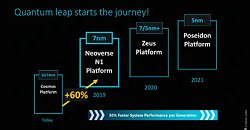Tuesday, December 3rd 2019

AWS Starts Designing 32-Core Arm Neoverse N1 CPU for Data Center
Amazon Web Services, a part of Amazon that is in charge of all things cloud, has announced plans to release 32 core CPU based on Arm Neoverse N1 microarchitecture that is designed to handle a diverse workload that today's cloud infrastructure needs. This new CPU should be the second iteration of AWS'es custom CPU based on the Arm architecture. First-generation AWS CPU was a processor called Graviton, which Amazon offered on-demand in the cloud.
The still-unnamed second-gen CPU will utilize a 7 nm manufacturing process if the Neoverce N1 core at its base is to be believed. Additionally, everything from the Neoverse line should translate to this next-gen CPU as well, meaning that there will be features like high frequency and high single-threaded performance, cache coherency, and interconnect fabric designed to connect special-purpose accelerators to the CPU complex. For reference, Arm's design of Neoverce N1 has a TDP of 105 W for the whole SoC and its packs 64 cores running at 3.1 GHz, delivering amazing power efficiency and high core count.
Source:
AnandTech
The still-unnamed second-gen CPU will utilize a 7 nm manufacturing process if the Neoverce N1 core at its base is to be believed. Additionally, everything from the Neoverse line should translate to this next-gen CPU as well, meaning that there will be features like high frequency and high single-threaded performance, cache coherency, and interconnect fabric designed to connect special-purpose accelerators to the CPU complex. For reference, Arm's design of Neoverce N1 has a TDP of 105 W for the whole SoC and its packs 64 cores running at 3.1 GHz, delivering amazing power efficiency and high core count.


10 Comments on AWS Starts Designing 32-Core Arm Neoverse N1 CPU for Data Center
A big win for ARM in the enterprise space, especially if AWS can make it work!
Amazon Announces Graviton2 SoC Along With New AWS Instances: 64-Core Arm With Large Performance Uplifts
Use it instead of your 3700x and see what happens.I bet ARM will try to reach for the Laptop segment for sure or even desktop at some point. That would be something. Imagine ARM competing with x86 architecture.